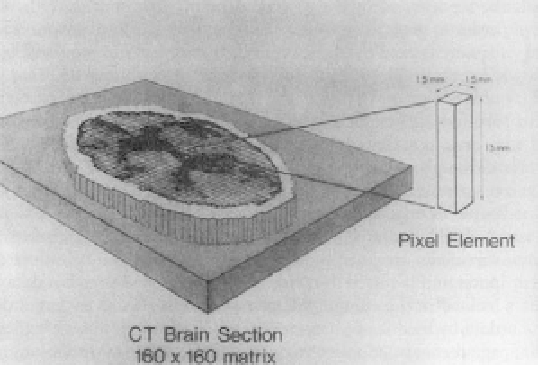Biomedical Engineering Reference
In-Depth Information
FIGURE 15.8
Sketch of a cross-sectional image available using computerized tomography. Each image is
divided into discrete three-dimensional sections of tissue referred to as voxels (or volume elements). On the computer
monitor, the slice is viewed in two dimensions as pixels (or picture elements)—in this case 1.5
1.5 mm.
To develop an image from the stored values of x-ray absorption, the computer initially
establishes a grid consisting of a number of small squares for the cross section of interest,
depending on the size of the desired display. The result of this process is something like
the mesh of strings in a tennis racket. Since the cross section of the body has thickness, each
of these squares represents a volume of tissue, a rectangular solid whose length is deter-
mined by the slice thickness and whose width is determined by the size of the matrix. Such
a three-dimensional block of tissue is referred to as a “voxel” (or “volume element”) and is
on the display in two dimensions as a “pixel” (or “picture element”) (Figure 15.8).
During the scanning process, each voxel is irradiated by a narrow beam of x-rays up to
180 times. Thus, the absorption caused by that voxel contributes to up to 180 absorption
measurements, each measurement part of a different projection. Since each voxel affects a
unique set of absorption measurements to which it has contributed, the computer calculates
the total absorption due to that voxel. Using the total absorption and the dimension of the
voxel, the average absorption coefficient of the tissues in that voxel is determined precisely
and displayed in a corresponding pixel as a shade of grey.
EXAMPLE PROBLEM 15.8
Demonstrate how x-rays are attenuated as they pass through a cross-sectional area of the
patient's body in multiple rays.
Solution
The cross section of interest can be considered to be made up of a set of blocks of material
(Figure 15.9). Each block has an attenuating effect upon the passage of the x-ray energy or
photons, absorbing some of the incident energy passing through it. In the line of blocks illustrated



